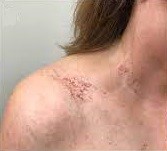RADIATION FIBROSIS SYNDROME

Radiation is a common treatment in cancer care, particularly those with head, neck and breast cancers, chosen for its ability to kill cancer cells.
Unfortunately cancer patients may be facing not only fighting the disease itself, but also side effects of treatments. The problem with radiation is that it may also affect the DNA of healthy cells within the treatment area, damage blood vessels which then affects blood flow and nutrition of the tissues, and increase production of a protein called fibrin, which then builds up and causes damage in radiated tissue over time. Features of RFS which may contribute to its progression include:-
- the presence of infiltrating inflammatory cells into tissue
- the differentiation of fibroblasts into myofibroblasts
- excessive production of extracellular matrix components including collagen
- vascular and parenchymal cell death and tissue damage due to excessive production of reactive oxygen species (ROS) and reactive nitrogen species (RNS)
- upregulation of pro-inflammatory cytokines and chemokines which bring bone marrow-derived cells to the site of injury, which may play a role in the progression of fibrosis
This means excessive, and often painful, scar tissue may be formed in the healthy tissue and this is known as radiation fibrosis, a condition which can be long lasting and progressive, but can be improved or stopped in its tracks. Radiation fibrosis can appear weeks, months, or even up to 10 years after treatment. If we use breast cancer as an example, this fibrotic scar tissue may not only develop in the breast tissue itself, but also in the chest wall, ribs and underlying lung tissue, potentially leading to pulmonary fibrosis, but RFS can present itself in the skin, gastrointestinal tract, muscle, and other tissues.
The risk of radiation fibrosis will depend on factors such as:-
- the radiation dose - severity of disease generally correlates with increased and prolonged doses of targeted radiation
- the size and location of the treatment area
- prior radiation treatment
- genetic susceptibility to fibrosis
- other diseases diabetes
Techniques such as intensity modulated radiation therapy (IMRT) and proton beam therapy, which help to reduce the amount of radiation delivered to the surrounding healthy tissues, and avoiding large single doses of radiation can minimise the risk of developing fibrosis.

SYMPTOMS
Symptoms of radiation fibrosis are collectively known as radiation fibrosis syndrome (RFS).
- SKIN – EARLY EFFECTS
- increased erythema
- desquamation (peeling)
- possible ulceration
- LATER EFFECTS
- Dermal fibrosis
- sebaceous and sweat gland atrophy
- hair loss
- telangiectasia (small widened blood vessels on the skin)
- GASTROINTESTINAL TRACT
- Pain
- blood loss
- diarrhoea
- faecal incontinence
- changes to bowel movements
- BREAST TISSUE - fibrosis can feel like a mass and make you worry that cancer has come back.
- Tenderness
- Redness
- Firmness (over time)
- LUNG TISSUE
- Pneumonitis often leads to respiratory dysfunction and decreased quality of life
- Shortness of breath
- Dry cough
GENERAL FIBROSIS SYMPTOMS
- Shortening of tissues
- Muscle and joint aches
- Contracture, weakness, pain and atrophy of muscle
- Bones to become weak and brittle
- Heart, lung, and nerve damage (neuropathy)
- Lymphoedema
- Unexplained weight loss
- "Clubbing" of the fingers or toes (widening and rounding of the tips)
- Osteopaenia (reduced bone mass)
- Osteoporosis (more severe loss of bone mass)
- Pain
TREATMENT
Treatment for RFS depends on the symptoms, location and side effects the patient is having, and is aimed at preventing progression and maintaining or restoring function.
- Physiotherapy to maintain/increase range of motion
- occupational therapy
- speech and swallow therapy
- surgery eg.autologous fat grafting where fat is removed from the body and injected into the radiated skin, rejuvenating affected skin and reducing radiation-related complications. This may help reverse some of the fibrosis or halt progression
- massage therapy (must be a certified oncology practitioner) - help increase or maintain range of motion, improve the appearance of skin and help relieve muscle spasms
- cancer rehabilitation specialists
- medication
- Pentoxifylline to promote blood flow in small blood vessels, often used in conjunction with vitamin E. Research has shown that pentoxifylline may also minimize injury to the lungs, skin, and soft tissues.
- Topical steroids, creams containing hyaluronic acid, and other creams or gels may help reduce skin-related symptoms of radiation therapy
- pain medications and opioids for pain
- medications for neuropathy eg. pregabalin
- muscle relaxants or trigger-point injections for spasms
- Botulinum toxin (Botox) injection may also be used for muscle spasms
- hyperbaric oxygen therapy has seen reported benefits but there is no solid evidence to back this up
- mental-health counselling and support groups for dealing with cancer and chronic conditions
